Optical Fiber Current Sensors Based on FBG and Magnetostrictive Composite Materials
Abstract
1. Introduction
2. Working Principle of the Sensor
2.1. Magnetic Circuit Sensing System
2.1.1. Magnetostrictive Material
2.1.2. Fiber Bragg Grating
2.1.3. Permanent Magnet
2.2. Optoelectronic Test System
3. Optical Fiber Current Sensor Based on Magnetostrictive Composite Materials
3.1. Sensor Structure
3.2. Magnetostrictive Composites
4. Prospect of Optical Fiber Current Sensor Based on Magnetostrictive Composite Materials
Author Contributions
Funding
Institutional Review Board Statement
Informed Consent Statement
Data Availability Statement
Conflicts of Interest
References
- Silva, R.M.; Martins, H.; Nascimento, I.; Baptista, J.M.; Ribeiro, A.L.; Santos, J.L.; Jorge, P.; Frazão, O. Optical current sensors for high power systems: A review. Appl. Sci. 2012, 2, 602–628. [Google Scholar] [CrossRef]
- Bohnert, K.; Gabus, P.; Kostovic, J.; Brandle, H. Optical fiber sensors for the electric power industry. Opt. Lasers Eng. 2005, 43, 511–526. [Google Scholar] [CrossRef]
- Zhang, W.C.; Lai, Y.B.; Zhao, H.; Zhang, L.Y.; Shi, Y.B. Structure optimization and temperature compensation model of GMM-FBG fiber optic current sensor. Electr. Mach. Control 2019, 23, 104–111. [Google Scholar]
- Wang, Z.S.; Wang, H.B.; Liu, X.H. Dynamic response of the output force of giant magnetostrictive materials. Int. J. Mech. Mater. Des. 2020, 16, 685–691. [Google Scholar]
- Adelsberg, N.; Weber, Y.; Yoff, A.; Shilo, D. Wireless thin layer force sensor based on a magnetostrictive composite material. Smart Mater. Struct. 2017, 26, 065013. [Google Scholar] [CrossRef]
- Li, B.S.; Zhong, X.J.; Tong, W.G. FBG current sensor based on magnetostrictive effect. J. Electr. Eng. Technol. 2009, 24, 95–100. [Google Scholar]
- Joule, J.P. On a new class of magnetic forces. Ann. Electr. Magn. Chem. 1842, 8, 219–224. [Google Scholar]
- Huang, J.H.; Nan, C.W.; Li, R.M. Micromechanics approach for effective magnetostriction of composite materials. J. Appl. Phys. 2002, 91, 9261–9266. [Google Scholar] [CrossRef]
- Olabi, A.G.; Grunwald, A. Design and application of magnetostrictive materials. Mater. Des. 2008, 29, 469–483. [Google Scholar] [CrossRef]
- Du, T.; Zhang, H.P. Application research of rare earth-iron series giant magnetostrictive materials. Met. Funct. Mater. 1997, 4, 173–176. [Google Scholar]
- Basumallick, N.; Chatterjee, I.; Biswas, P.; Dasgupta, K.; Bandyopadhyay, S. Fiber bragg grating accelerometer with enhanced sensitivity. Sens. Actuators A Phys. 2011, 173, 108–115. [Google Scholar] [CrossRef]
- Liu, H.L.; Or, S.W.; Tam, H.Y. Magnetostrictive composite-fiber bragg grating (MC-FBG) magnetic field sensor. Sens. Actuators A Phys. 2012, 173, 122–126. [Google Scholar] [CrossRef]
- Satpathi, D.; Moore, J.A.; Ennis, M.G. Design of a Terfenol-D based fiber-optic current transducer. IEEE Sens. J. 2005, 5, 1057–1065. [Google Scholar] [CrossRef]
- Cremonezi, A.O.; Ferreira, E.C.; Biazon, A.J.; Dias, J.A.S. A fiber bragg grating rms current transducer based on the magnetostriction effect using a Terfenol-D toroidal-modulator. IEEE Sens. J. 2013, 13, 683–690. [Google Scholar] [CrossRef]
- De Nazare, F.V.B.; Werneck, M.M. Compact optomagnetic bragg-grating-based current sensor for transmission lines. IEEE Sens. J. 2015, 15, 100–109. [Google Scholar] [CrossRef]
- Dante, A.; Lopez, J.D.; Trovão, T.; Mok, R.W.; Carvalho, C.C.; Allil, R.C.D.S.B.; Werneck, M.M. A compact FBG-Based toroidal magnetostrictive current sensor with reduced mass of Terfenol-D. In OSA Optical Sensors and Sensing Congress 2019; Optical Society of America: Washington, DC, USA, 2019. [Google Scholar]
- Dante, A.; Lopez, J.D.; Carvalho, C.C.; Allil, R.C.D.B.; Werneck, M.M. A compact FBG-Based magnetostrictive optical current sensor with reduced mass of Terfenol-D. IEEE Photonics Technol. Lett. 2019, 31, 1461–1464. [Google Scholar] [CrossRef]
- Lopez, J.D.; Dante, A.; Bacurau, R.M.; Cremonezi, A.O.; Mok, R.W.; Carvalho, C.C.; Allil, R.C.S.B.; Ferreira, E.C.; Werneck, M.M. Fiber-Optic current sensor based on FBG and optimized magnetostrictive composite. IEEE Photonics Technol. Lett. 2019, 31, 1987–1990. [Google Scholar] [CrossRef]
- Lopez, J.D.; Dante, A.; Cremonezi, A.O.; Bacurau, R.M.; Carvalho, C.C.; da Silva Barros Allil, R.C.; Ferreira, E.C.; Werneck, M.M. Fiber-Optic current sensor based on FBG and Terfenol-D with magnetic flux concentration for enhanced sensitivity and linearity. IEEE Photonics Technol. Lett. 2020, 20, 3572–3578. [Google Scholar] [CrossRef]
- Wang, S.; Wan, F.; Zhao, H.; Chen, W.; Zhang, W.; Zhou, Q. A sensitivity-enhanced fiber grating current sensor based on giant magnetostrictive material for large-current measurement. Sensors 2019, 19, 1755. [Google Scholar] [CrossRef]
- Jiang, M.H.; Gu, Z.F.; Liu, X.Y. Study on preparation and properties of Al/Tb0.30Dy0.70Fe1.95 composites. Powder Metall. Ind. 2009, 27, 119–122, 126. [Google Scholar]
- Jiang, M.H.; Gu, Z.F.; Liu, X.Y.; Cheng, J.; Zhou, X.J. Preparation of Al/Tb0.30Dy0.70Fe1.95 magnetostrictive composites by powder sintering. J. Aeronaut. Mater. 2009, 29, 13–16. [Google Scholar]
- Lim, S.H.; Kim, S.R.; Kang, S.Y.; Park, J.K.; Nam, J.T.; Son, D. Magnetostrictive properties of polymer-bonded Terfenol-D composites. J. Magn. Magn. Mater. 1999, 191, 113–121. [Google Scholar] [CrossRef]
- Kaleta, J.; Lewandowski, D.; Mech, R. Magnetostriction of field-structural composite with Terfenol-D particles. Arch. Civ. Mech. Eng. 2015, 15, 897–902. [Google Scholar] [CrossRef]
- Quintero, S.; Braga, A.; Weber, H.; Bruno, A.C.; Araujo, J.F.D.F. A magnetostrictive composite-fiber bragg grating sensor. Sensors 2010, 10, 8119–8128. [Google Scholar] [CrossRef]
- Zhao, X.; Zhao, L.; Wang, R.; Yan, J.; Tian, X.; Yao, Z.; Tegus, O. The microstructure, preferred orientation and magnetostriction of Y doped Fe-Ga magnetostrictive composite materials. J. Magn. Magn. Mater. 2019, 491, 165568.1–165568.8. [Google Scholar] [CrossRef]
- Dong, X.; Qi, M.; Guan, X.; Li, J.; Ou, J. Magnetostrictive properties of titanate coupling agent treated Terfenol-D composites. J. Magn. Magn. Mater. 2012, 324, 1205–1208. [Google Scholar] [CrossRef]
- Dong, X.; Ou, J.; Guan, X.; Qi, M. Optimal orientation field to manufacture magnetostrictive composites with high magnetostrictive performance. J. Magn. Magn. Mater. 2010, 322, 3648–3652. [Google Scholar] [CrossRef]
- Li, B.; Zhang, T.; Wu, Y.; Jiang, C. High-performance magnetostrictive composites with large particles volume fraction. J. Alloy. Compd. 2019, 805, 1266–1270. [Google Scholar] [CrossRef]
- Tomiczek, A.E.; Mech, R.; Dobrzanski, L.A.; Tanski, T. Magnetomechanical properties of composite materials with giant magnetostriction. Arch. Metall. Mater. 2015, 60, 1819–1824. [Google Scholar] [CrossRef]
- Tomiczek, A.E.; Mech, R.; Dobrzanski, L.A. Variation of magneto-mechanical properties in giant magnetostrictive composite materials. Polym. Compos. 2017, 38, 797–802. [Google Scholar] [CrossRef]
- Tian, J.J.; Zuo, Z.J.; Pan, D.A.; Zhang, S.G. Bonded Terfenol-D composites with low eddy current loss and high magnetostriction. Rare Met. 2010, 29, 579–582. [Google Scholar] [CrossRef]
- Jia, A.; Zhang, T.L.; Meng, H.; Jiang, C.B. Magnetostriction and eddy current loss of bonded giant magnetostrictive particle. Acta Metall. Sin. 2009, 45, 1473–1478. [Google Scholar]
- Zhang, Z.R.; Liu, J.J.; Song, X.H.; Li, F.; Zhu, X.Y.; Si, P.Z. Magnetoelastic properties of epoxy resin based TbxHo0.9-xNd0.1(Fe0.8Co0.2)1.93 particulate composites. Mater. Sci. Pol. 2017, 35, 81–86. [Google Scholar] [CrossRef][Green Version]
- Nersessian, N.; Or, S.W.; Carman, G.P. Magneto-thermo-mechanical characterization of 1–3 type polymer-bonded Terfenol-D composites. J. Magn. Magn. Mater. 2003, 263, 101–112. [Google Scholar] [CrossRef]
- Li, S.Y.; Wang, B.W.; Weng, L.; Zhou, Y.; Sun, Y.; Huang, W.M. The effect of magnetic field heat treatment on magnetostriction of Terfenol-D 2–2 composites. J. Magn. Magn. Mater. 2008, 320, 806–809. [Google Scholar] [CrossRef]
- Yan, J.C.; Lu, S.X.; Yang, S.Q.; He, S.Y. Simulation on magnetostriction strain of polymer-bonded Terfenol-D composites. J. Mater. Sci. Technol. 2003, 19, 103–104. [Google Scholar]
- Rodriguez, C.; Rodriguez, M.; Orue, I.; Vilas, J.L.; Barandiaran, J.M.; Gubieda, M.L.F.; Leon, L.M. New Elastomer-Terfenol-D magnetostrictive composites. Sens. Actuators A Phys. 2009, 149, 251–254. [Google Scholar] [CrossRef]
- Jiang, M.H.; Gu, Z.F.; Liao, H.Y.; Liu, X.Y. Preparation and characterization of high performance bonded giant magnetostrictive composites. J. Sichuan Univ. 2008, 5, 116–120. [Google Scholar]
- Jiang, M.H.; Gu, Z.F.; Liu, X.Y.; Cheng, G.; Zhou, H.Y. Study on magnetic properties of high performance rare earth-iron giant magnetostrictive composites. J. Sichuan Univ. 2009, 41, 126–131. [Google Scholar]
- Jiang, M.H.; Zhu, Y.C.; Yang, P.S. Preparation technology, microstructure and magnetostrictive properties of rare earth giant magnetostrictive composites. Rear Earth 2004, 6, 26–30. [Google Scholar]
- Dong, X.F.; Guan, X.C.; Ou, J.P.; Qi, M. Effect of particle size distribution on properties of resin-based magnetostrictive composites. Acta Mater. Compos. Sin. 2010, 27, 1–8. [Google Scholar]
- Deng, T.; Gu, Z.F.; Cheng, G. Effect of bonding process on magnetostrictive properties of high praseodymium alloy composites. Electr. Eng. Mater. 2011, 2, 30–32. [Google Scholar]
- Jiang, L.P.; Zhao, Z.Q.; Wu, S.X.; Huang, J.M.; Wen, Y.C.; Zuo, L. Study on the preparation technology of bonded rare earth magnetostrictive materials. Rear Earth 2005, 4, 30–32. [Google Scholar]
- Guan, X.C.; Dong, X.F.; Ou, J.P. Preparation and properties of resin-based magnetostrictive composites under ultrasound. Funct. Mater. 2008, 8, 1264–1267. [Google Scholar]
- Guan, X.C.; Dong, X.F.; Ou, J.P. Predicting performance of polymer-bonded Terfenol-D composites under different magnetic fields. J. Magn. Magn. Mater. 2009, 321, 2742–2748. [Google Scholar] [CrossRef]
- Guan, X.C.; Dong, X.F.; Ou, J.P. Effect of thermal residual stress on dynamic and static magnetostrictive properties of resin-based magnetostrictive composites. Acta Mater. Compos. Sin. 2008, 1, 11–16. [Google Scholar]
- Zhao, G.H.; Liu, Y.Q.; Zhang, H.P. Study on phenolic bonded TbDyFe rare earth magnetostrictive material. Powder Metall. Ind. 2019, 29, 55–60. [Google Scholar]
- Lin, L.L.; Liu, J.J.; Shen, W.C.; Ding, Q.L.; Wang, M.K.; Du, J.; Si, P.Z. Magnetomechanical behavior of Tb0.2Dy0.8-xPrx(Fe0.8Co0.2)1.93/epoxy pseudo-1–3 particulate composites. Appl. Phys. A Mater. Sci. Process. 2018, 124, 706–713. [Google Scholar] [CrossRef]
- Meng, H.; Zhang, T.L.; Jiang, C.B.; Xu, H.B. Grain-<111>-oriented anisotropy in the bonded giant magnetostrictive material. Appl. Phys. Lett. 2010, 96, 102501. [Google Scholar] [CrossRef]
- Zhao, R.; Wang, B.W.; Cao, S.Y.; Huang, W.M.; Lu, Q.G.; Yan, J.W. Magnetostrictive and magnetic properties of Tb0.29Dy0.48Ho0.23Fe1.9 fiber/epoxy composites. J. Magn. 2018, 23, 280–284. [Google Scholar] [CrossRef]
- Dong, X.; Qi, M.; Guan, X.; Ou, j. Microstructure analysis of magnetostrictive composites. Polym. Test. 2010, 29, 369–374. [Google Scholar] [CrossRef]



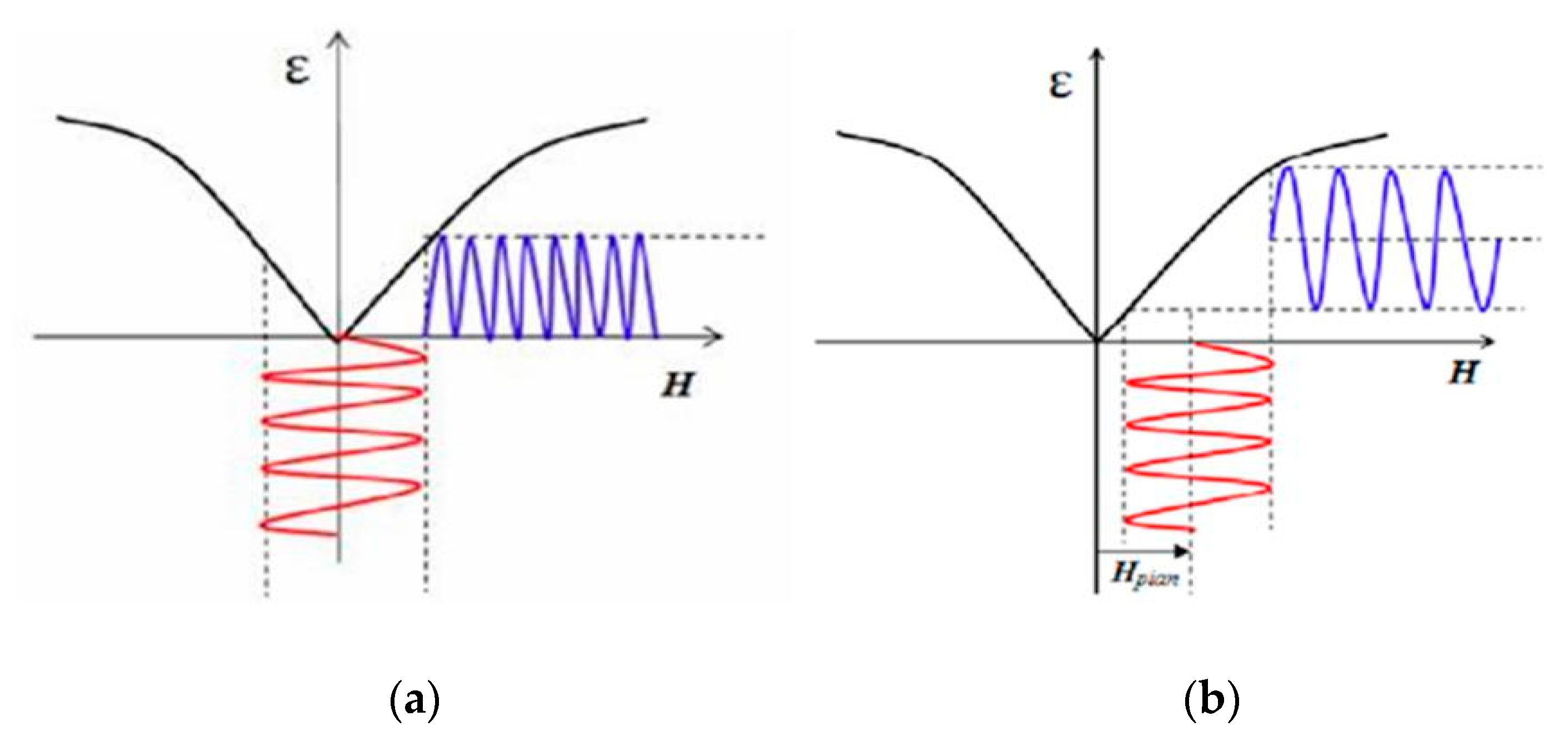

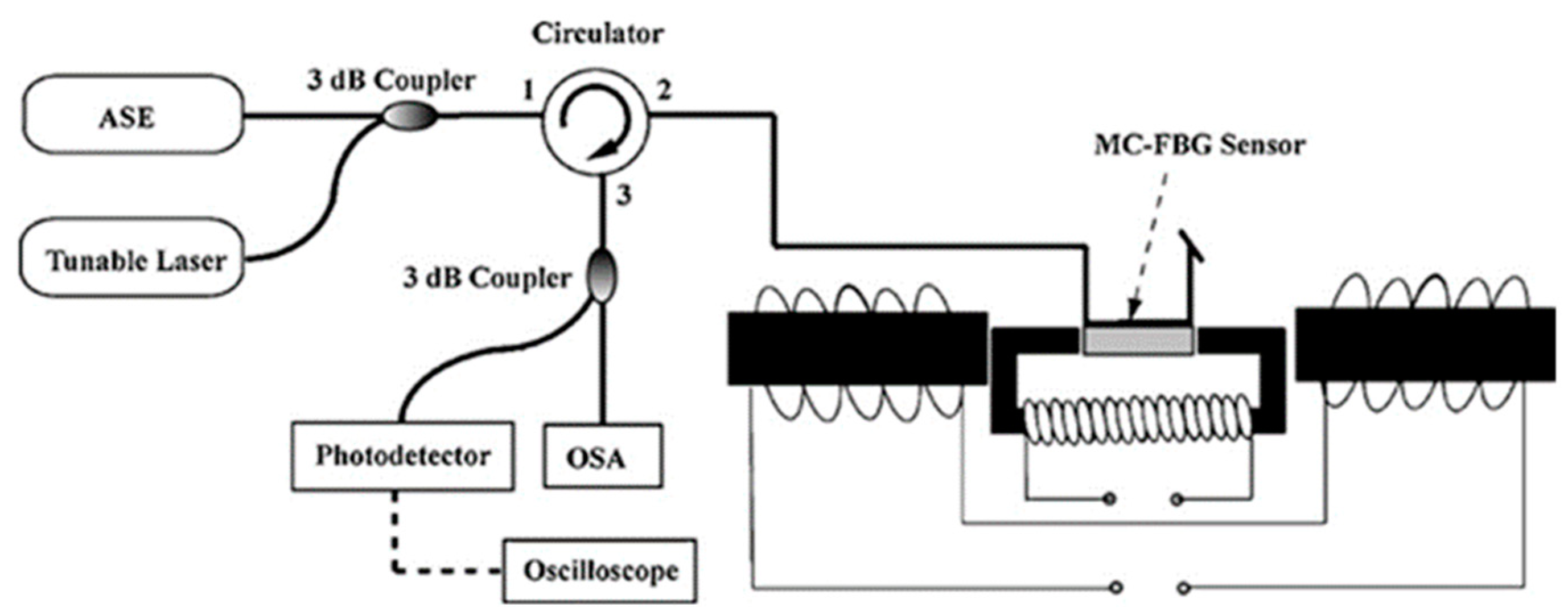
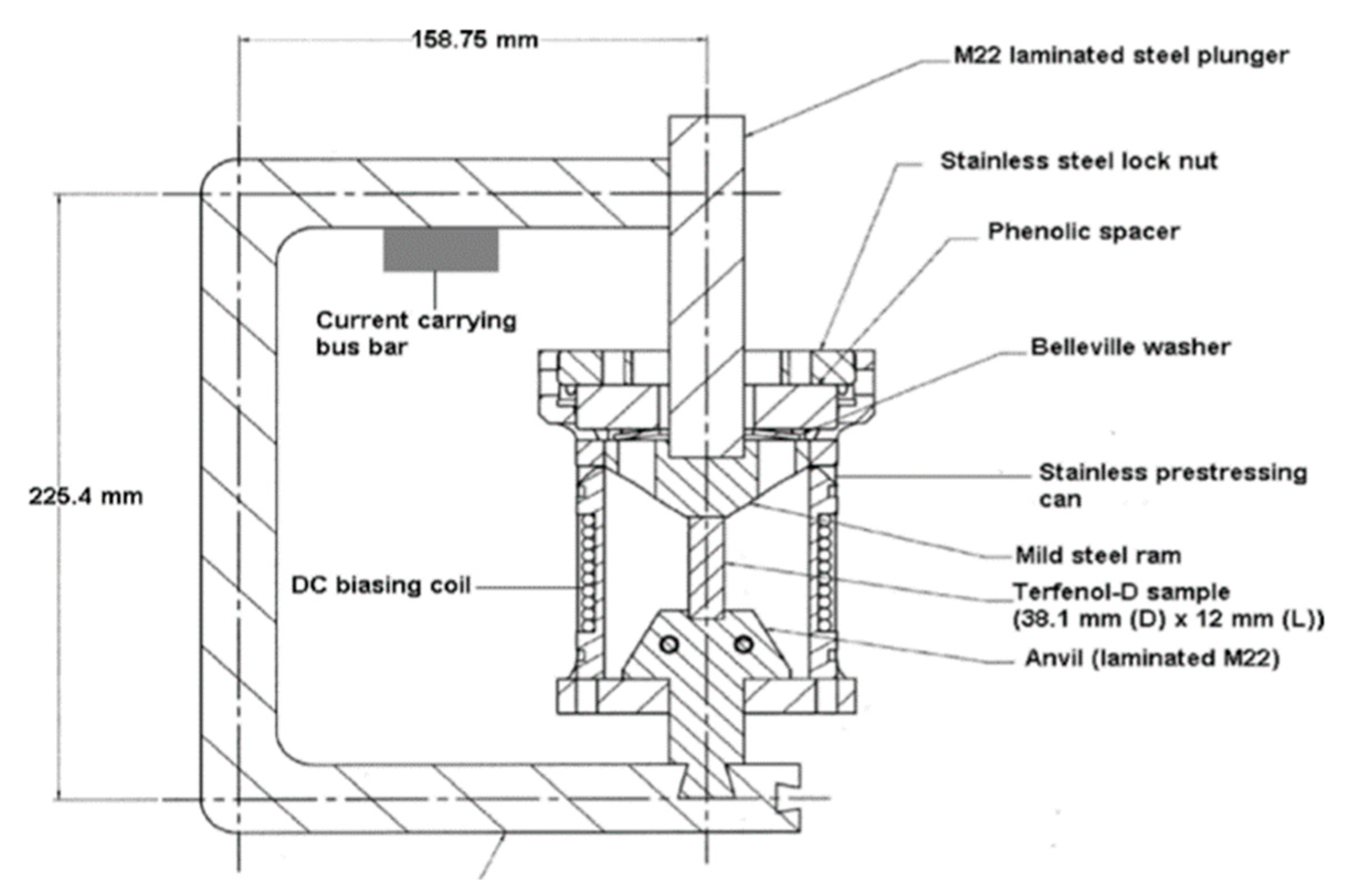
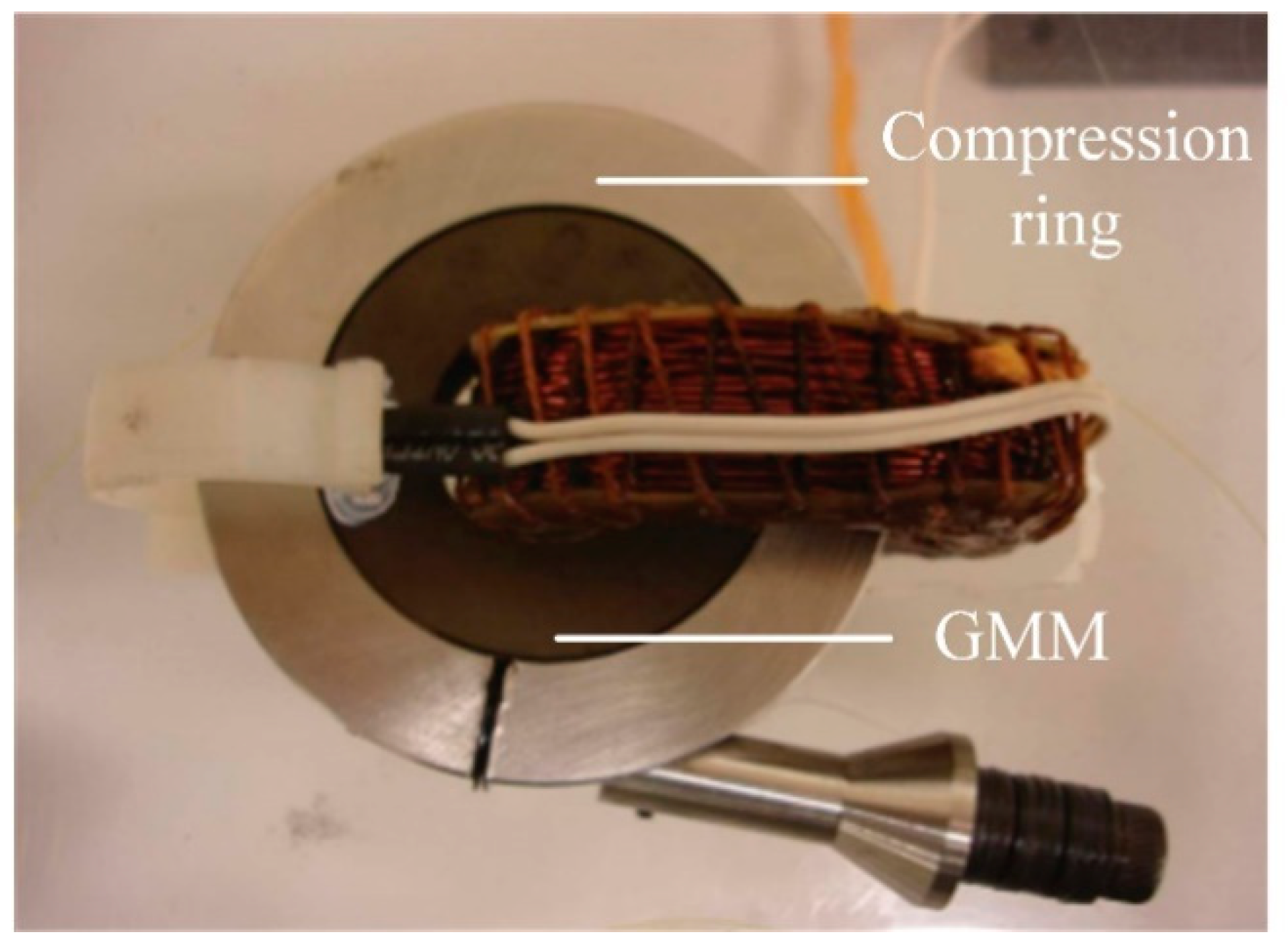

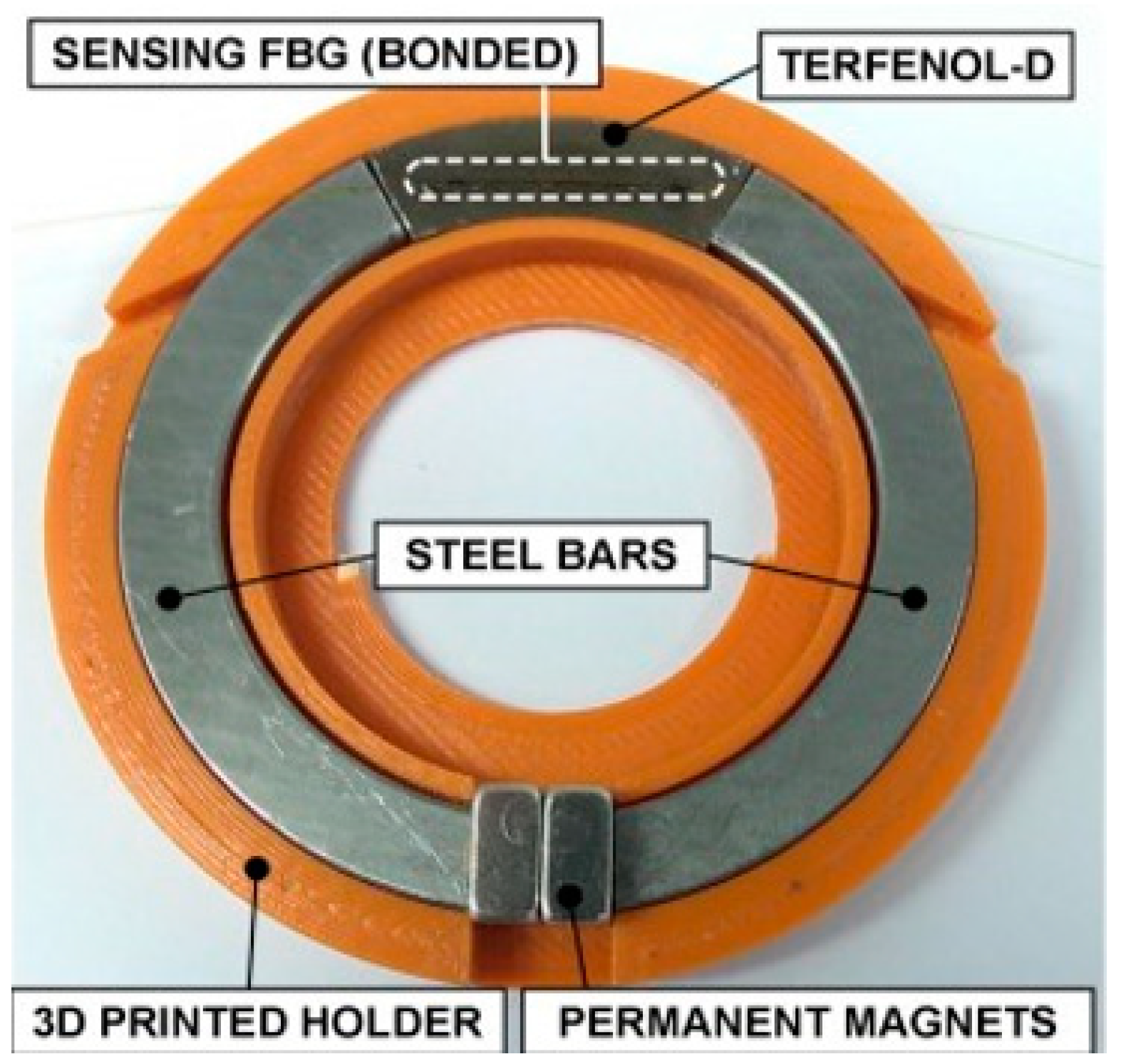
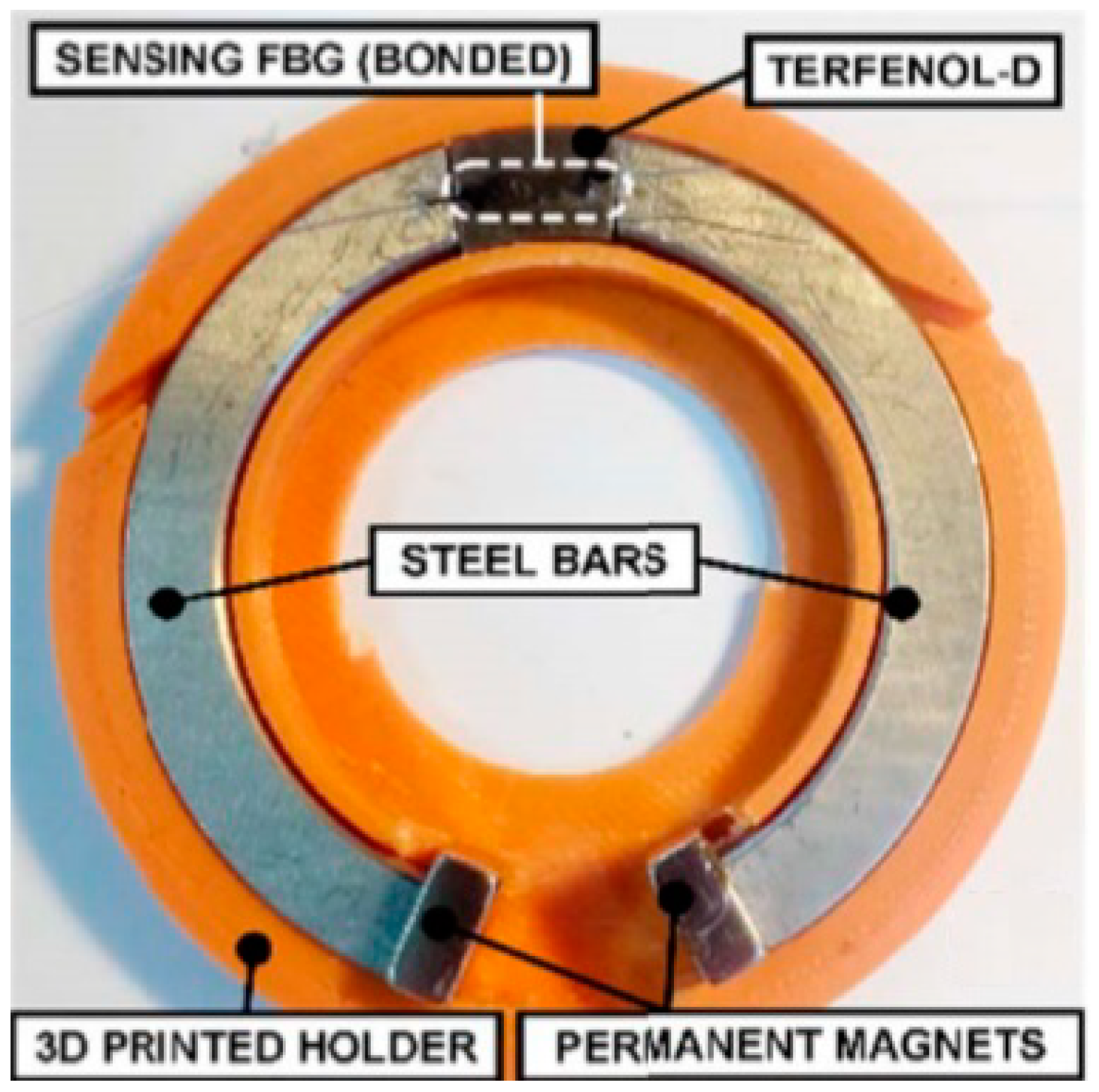


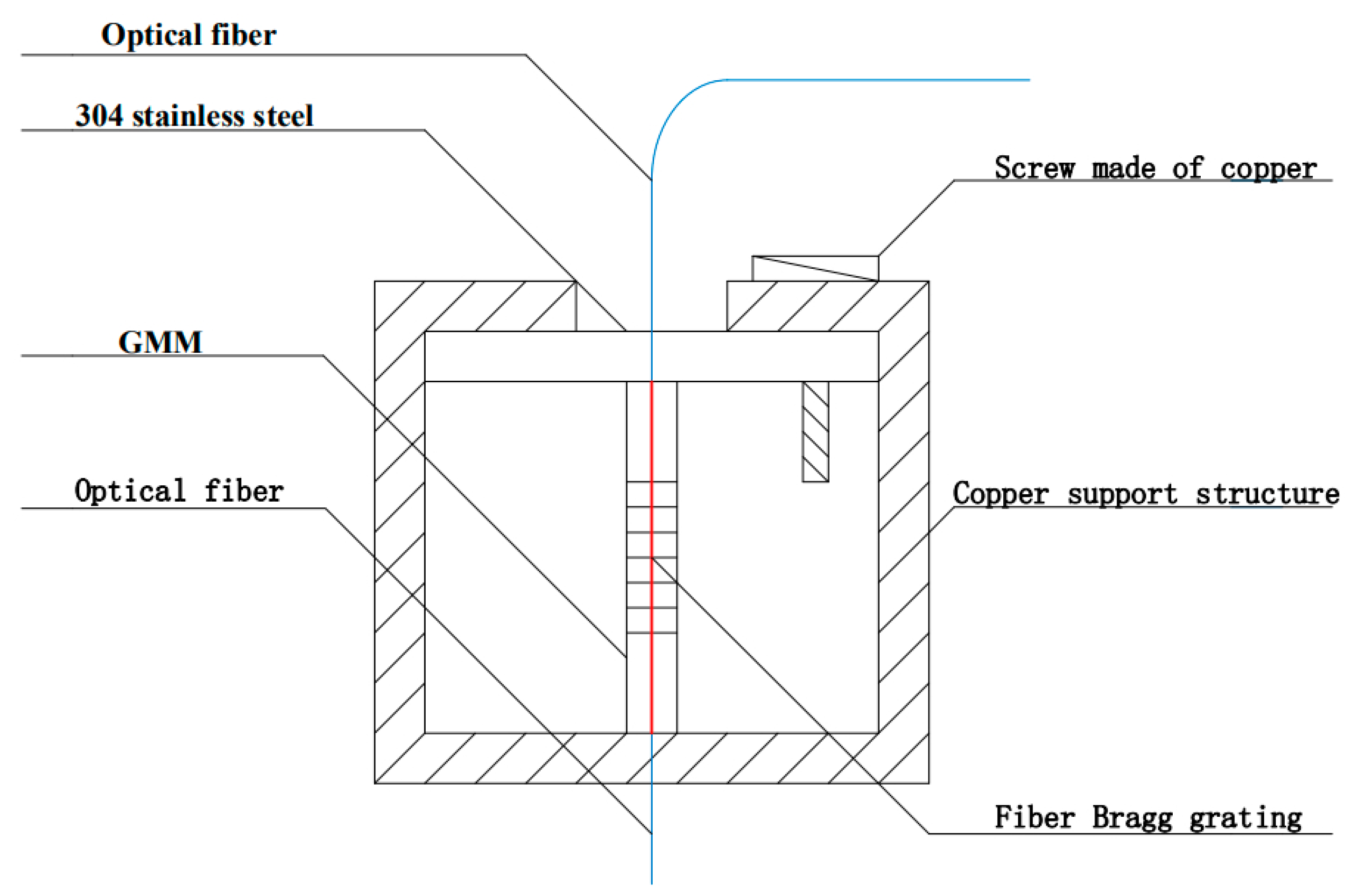
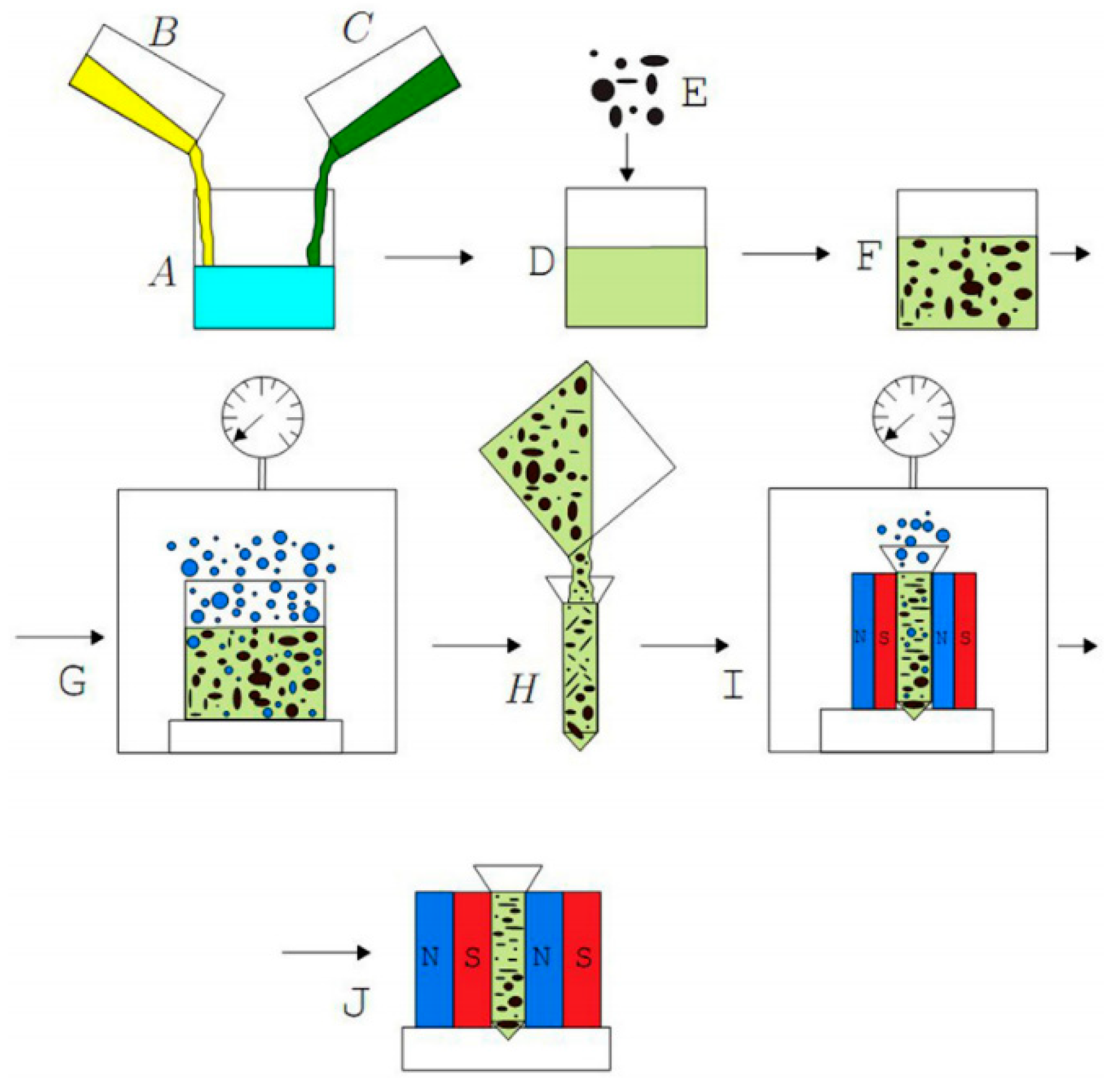

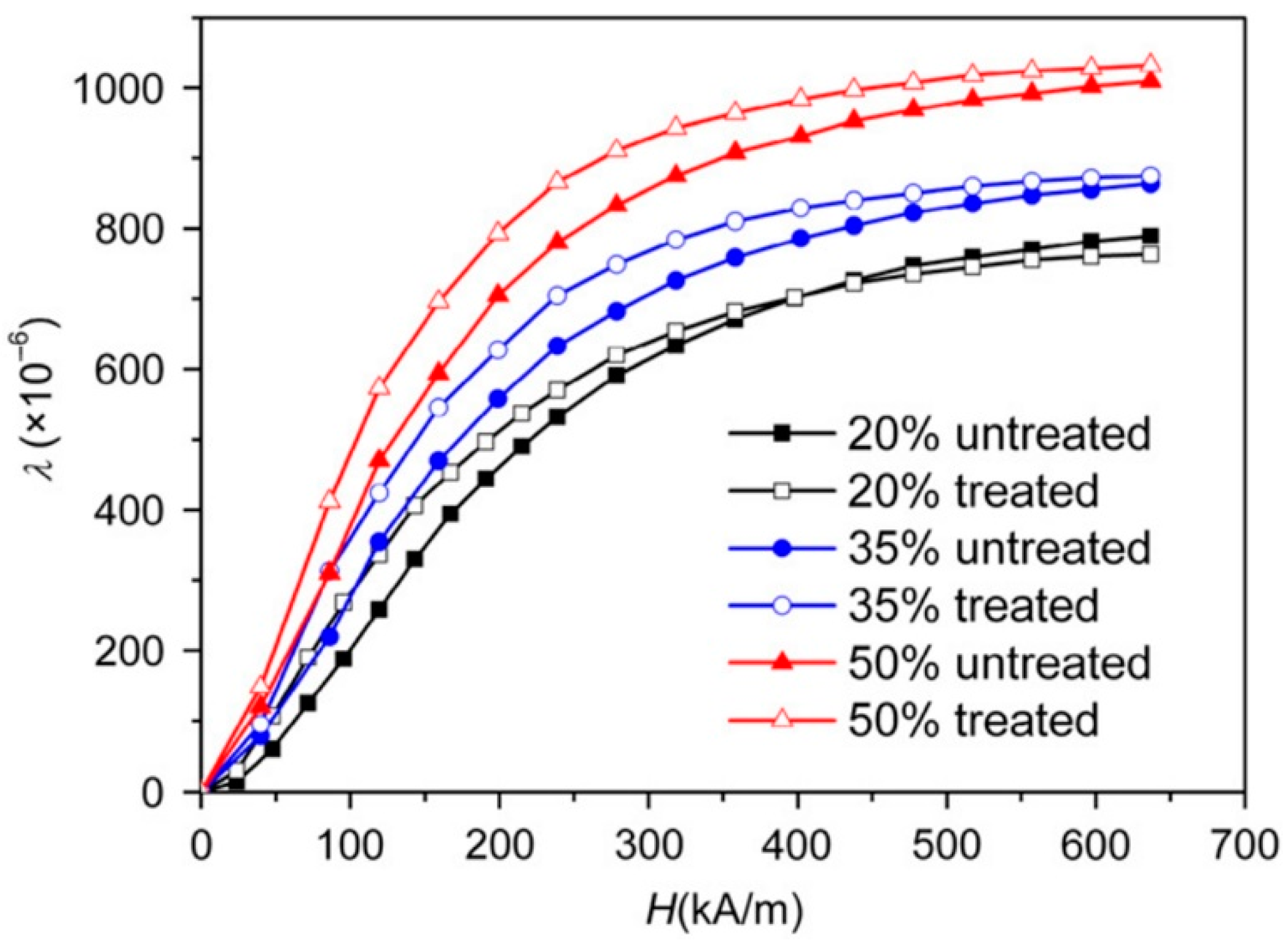

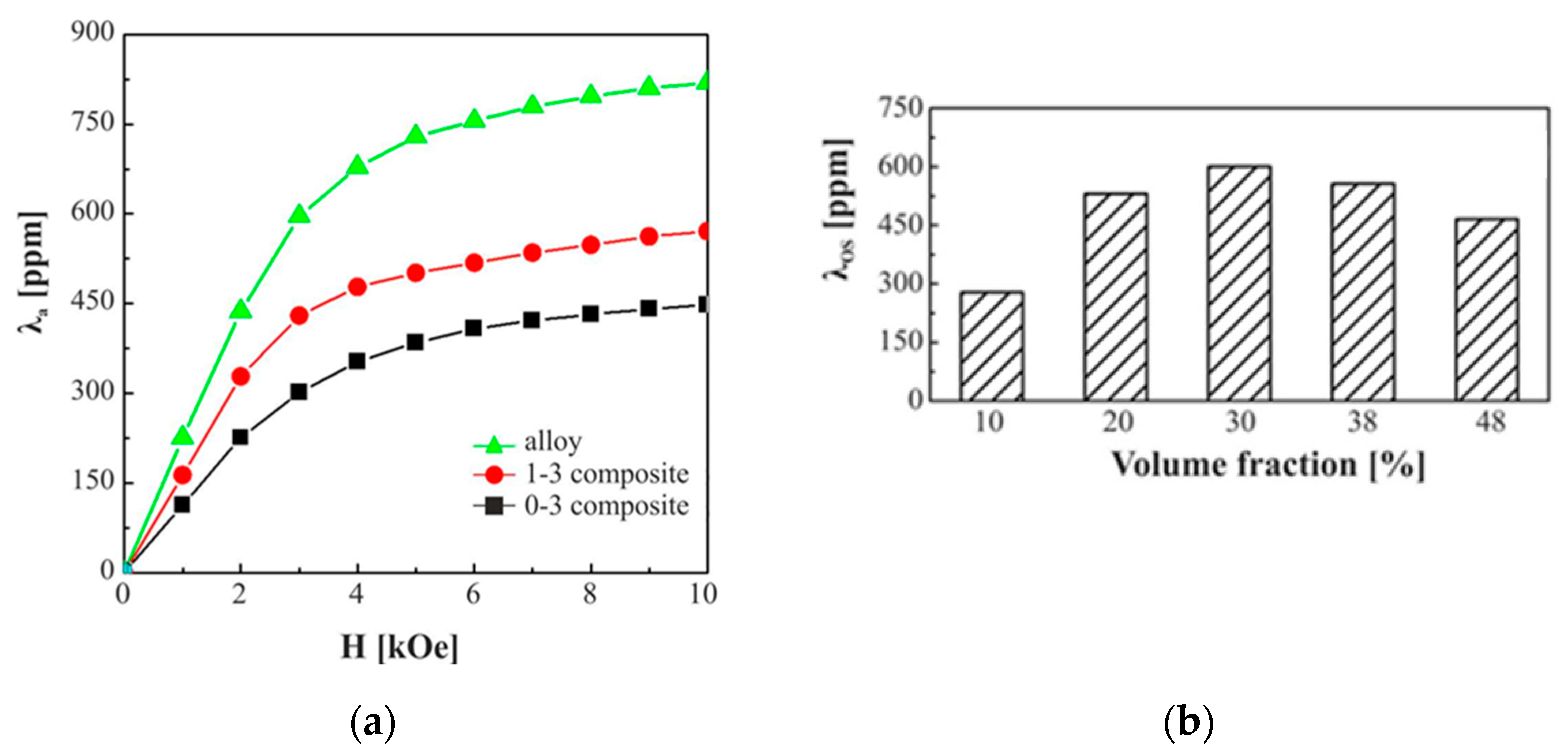
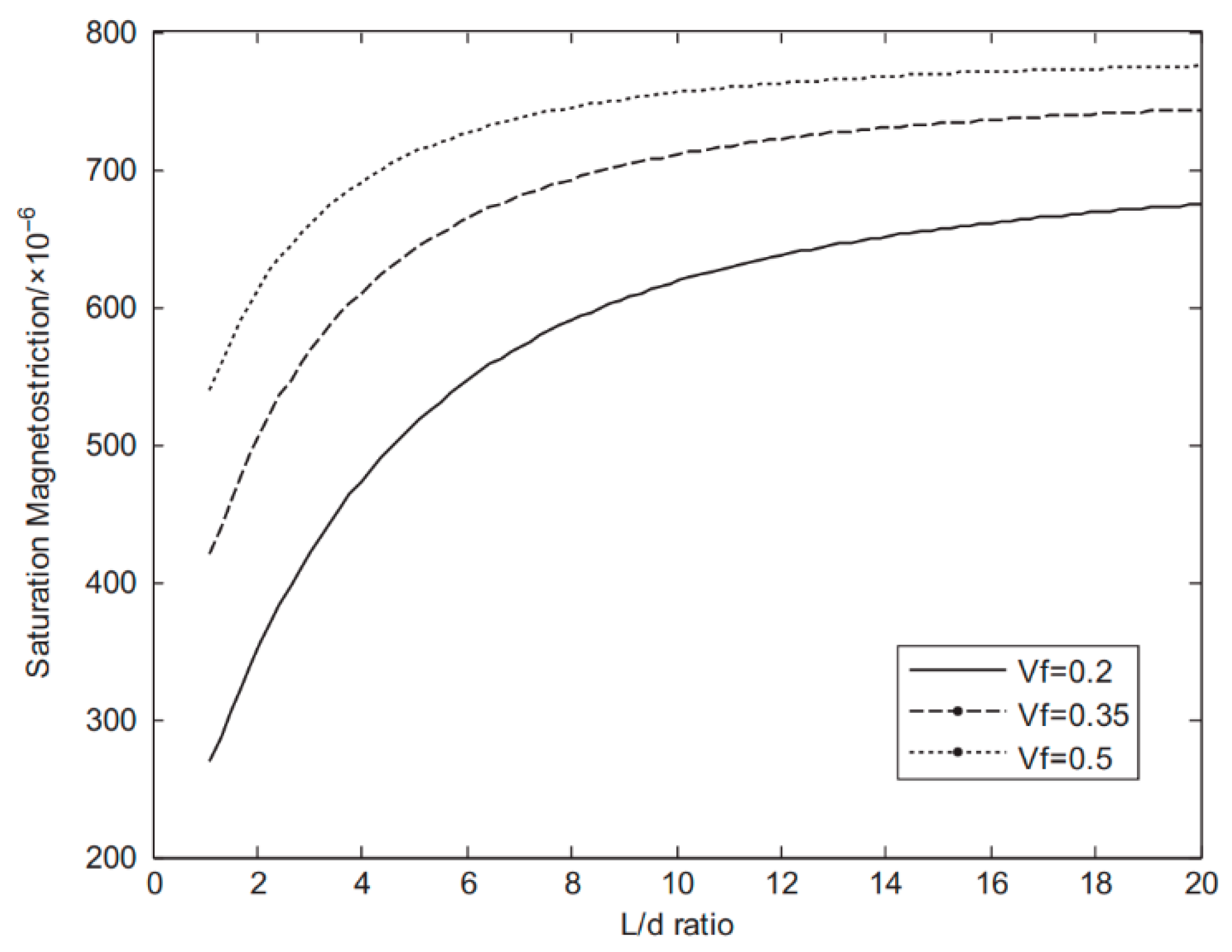
| Reference | Geometry | TD Mass | Linear Range |
|---|---|---|---|
| [13] | Cylindrical | 40 | 250–700 A |
| [14] | Toroidal | 144 | 320–900 A |
| [15] | Cubic | 74 | / |
| [16] | Toroidal | 5.6 | 105–650 A |
| [17] | Toroidal | 2.0 | 50–400 A |
| [18] | Hyperbolic | 1.5 | 15–450 A |
| [19] | Cuboid | 0.42 | 100–800 A |
| Serial Number | Author | Architectural Feature | Advantages and Disadvantages |
|---|---|---|---|
| 1 | Debashis Satpathi [13] | 1. 40 g cylindrical rod magnetostrictive material 2. preloading stress mechanical device 3. DC bias coil | The linearity of the sensor is high, but the structure is complex and the sensor is active. |
| 2 | Cremonezi [14] | 1. 144 g annular solid magnetostrictive material 2. stainless-steel compression ring | The measurement of alternating current is realized with small measurement error, but the frequency-doubling phenomenon will occur in the measurement process. |
| 3 | Nazaré and Werneck [15] | 1. 74 g solid cuboid magnetostrictive material 2. permanent magnet | The sensor is passive and eliminates the phenomenon of frequency-doubling, but magnetostrictive materials are expensive and fragile. |
| 4 | Alex Dante [16] | 1. 5.6 g annular magnetostrive material 2. annular magnetic conductive material | The cost of the sensor is greatly reduced, and the sensitivity is high, but the magnetostrictive material is difficult to form. |
| 5 | Alex Dante [17] | 1. 2.0 g annular magnetostrive material | Further reduce the cost and improve the sensitivity, which is suitable for fault detection. |
| 6 | Juan D. Lopez [18] | 1. 1.5 g hyperboloid magnetostrictive material 2. open-loop structure | Lower cost, higher sensitivity, faster response time, and easy installation. |
| 7 | Juan D. Lopez [19] | 1. 0.42 g rectangular magnetostriction material 2. circular magnetic permeability material from coarse to fine | The cost is the lowest, the magnetic flux density is concentrated and the maximum non-linear error of the sensor is reduced, but the temperature error is not compensated. |
| 8 | S. Wang [20] | 1. The T-shaped structure is placed in the copper support structure 2. the copper screw exerts pressure | Sensitivity is enhanced, but the structure is complex. |
| Serial Number | Influencing Factors of Properties of Composite Materials | Views of Different Authors |
|---|---|---|
| 1 | Preloading stress | 1. JKaleta et al. think that the optimum preloading stress is 9 MPa 2. Quintero et al. think that the optimum preloading stress is 8.6 MPa 3. Bochen Li et al. think that the best preloading stress is 10 MPa 4. Tomiczek et al. think that the best preloading stress is 2 MPa 5. Li et al. think that the best preloading stress is 6 MPa 6. Jiuchun Yan et al. the optimum preloading stress is 14 MPa 7. Hao Meng et al. think that the best preloading stress is 17 MPa |
| 2 | Orientation magnetic field direction | GMPC with vertical orientation magnetic field direction is better than GMPC with parallel orientation magnetic field direction |
| 3 | Orientation magnetic field strength | 1. Xufeng Dong et al. believe that the optimal orientation magnetic field strength of GMPC with particle volume fractions of 20%, 30%, and 50% are 30 kA/m, 80 kA/m and 100 kA/m, respectively. 2. Hao Meng et al. think that the best orientation magnetic field is 8000 Oe. 3. Dong et al. think that the best orientation magnetic field is 100 kA/m |
| 4 | Particle surface treatment | GMPC treated with coupling agent is better than GMPC untreated with coupling agent |
| 5 | Types of adhesives | Epoxy resin is superior to polyurethane resin |
| 6 | Segment soft-hard ratio | C. Rodríguez et al. think that the best segment soft-hard ratio is 1.5 |
| 7 | Temperature | Nersesse Nersessian et al. think that the best temperature is 0 °C or 10 °C |
| 8 | Particle volume fraction | 1. Quintero thinks that the best particle volume fraction is 30% 2. Bochen Li et al. think that the best particle volume fraction is 57% 3. Nersesse Nersessian et al. think that the best particle volume fraction is 50% 4. Jiuchun Yan et al. think that the best particle volume fraction is 85% |
| 9 | Particle mass fraction | 1. Jia Ao et al. think that the best particle mass fraction is 90% 2. Rodríguez et al. think that the best particle mass fraction is 70% 3. Minhong Jiang and others believe that the best particle mass fraction is 93% |
| 10 | Forming pressure | 1. Jianjun Tian et al. and Jia Ao et al. think that the best molding pressure is 200 MPa 2. Ting Deng and others think that the best molding pressure is 150 MPa 3. Guiheng Zhao and others believe that the best molding pressure is 400 MPa |
| 11 | Doping rare-earth elements | GMPC doped with rare-earth elements is better than GMPC undoped with rare-earth elements |
| 12 | Magnetic heat treatment | GMPC after magnetic field heat treatment is better than GMPC without magnetic field heat treatment |
| 13 | Particle size of magnetostrictive material | 1. Quintero et al. and Z.R. ZHANG et al. think that the best particle size range is > 200 μm 2. Tomiczek et al. think that the best particle size range is 106–212 μm 3. Jianjun Tian et al. think that the best particle size range is 50–80 μm 4. Rodríguez et al. think that the best particle size range is 212–300μm 5. Minhong Jiang and others think that the best particle size range is 450~900 μm 6. Xufeng Dongand others think that the best particle size range is 30~500 μm 7. Ting Deng et al. think that the best particle size range is 100~150 μm 8. Guiheng Zhao and others believe that the best particle size range is 250~420 μm |
| 14 | Preparation technology | The composites treated by high-energy ultrasonic method are better than those treated by mechanical stirring method |
| 15 | Curing temperature | Xinchun Guan and others believe that the best curing temperature is 80 °C |
| 16 | Particle aspect ratio | Xinchun Guan and others believe that the best aspect ratio of particles is 10 |
| 17 | Powder crystal orientation | The properties of composites with different crystal orientations are different |
| 18 | Types of magnetostrictive materials | The properties of composites with different kinds of magnetic field stretching materials are different |
Publisher’s Note: MDPI stays neutral with regard to jurisdictional claims in published maps and institutional affiliations. |
© 2020 by the authors. Licensee MDPI, Basel, Switzerland. This article is an open access article distributed under the terms and conditions of the Creative Commons Attribution (CC BY) license (http://creativecommons.org/licenses/by/4.0/).
Share and Cite
Xu, S.; Peng, Q.; Li, C.; Liang, B.; Sun, J.; Xing, F.; Xue, H.; Li, M. Optical Fiber Current Sensors Based on FBG and Magnetostrictive Composite Materials. Appl. Sci. 2021, 11, 161. https://doi.org/10.3390/app11010161
Xu S, Peng Q, Li C, Liang B, Sun J, Xing F, Xue H, Li M. Optical Fiber Current Sensors Based on FBG and Magnetostrictive Composite Materials. Applied Sciences. 2021; 11(1):161. https://doi.org/10.3390/app11010161
Chicago/Turabian StyleXu, Shaoyi, Qiang Peng, Chuansheng Li, Bo Liang, Junwen Sun, Fangfang Xing, Hongyu Xue, and Ming Li. 2021. "Optical Fiber Current Sensors Based on FBG and Magnetostrictive Composite Materials" Applied Sciences 11, no. 1: 161. https://doi.org/10.3390/app11010161
APA StyleXu, S., Peng, Q., Li, C., Liang, B., Sun, J., Xing, F., Xue, H., & Li, M. (2021). Optical Fiber Current Sensors Based on FBG and Magnetostrictive Composite Materials. Applied Sciences, 11(1), 161. https://doi.org/10.3390/app11010161




